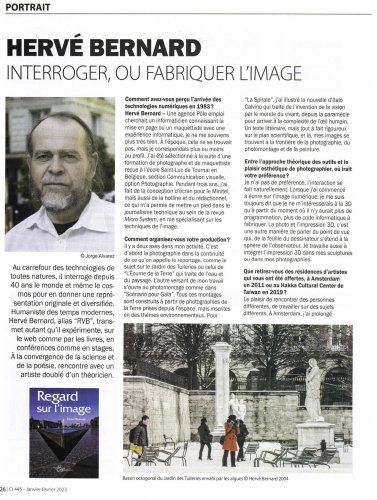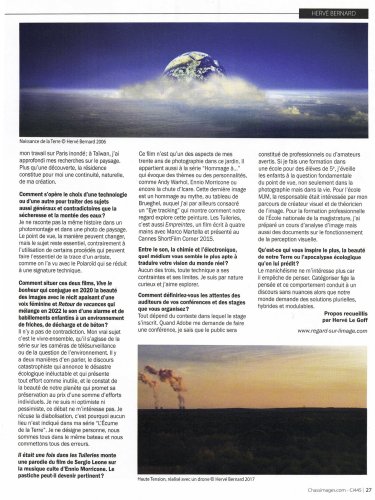- Questioning and making the image
At the crossroads of all kinds of technologies, he has been questioning the world and even the cosmos for 40 years to give an original and diversified representation.
A modern-day humanist, Hervé Bernard, alias « RVB », transmits as much as he experiments, on the web as well as in books, in conferences as well as in courses.
At the convergence of science and poetry, meeting with an artist and a theorist.
How did you perceive the arrival of digital technologies in 1983 ?
Hervé Bernard - A Pôle emploi agency was looking for a computer specialist with knowledge of page layout or a layout artist with computer experience, I don’t remember exactly. At the time, this was not available, but I more or less matched the profile. I was selected after training as a photographer and layout artist at the Saint-Luc school in Tournai, Belgium, in the Visual Communication section, with a major in photography.
For three years, I did screen design for the Minitel, but also hotline and editorial work, which allowed me to get my foot in the door of technical journalism within the magazine Micro System, specializing in image techniques.
How do you organize your production ?
There are two axes in my activity. The first is photography in the continuity of what is called reportage, like the subject on the Jardin des Tuileries or that of « L’Écume de la Terre » which deals with water and landscape. The other side of my work opens up to photomontage as in « Scenario for Gaia ». All these montages are built from photographs of the Earth taken from space, but inscribed in environmental themes. For « La Spirale », I illustrated the short story by Italo Calvino which deals with the invention of vision by the living world, from the paramecium to the complexity of the human eye. A literary text, but quite rigorous on the scientific level, and there, my images are at the border of photography, photomontage and painting.
Between the theoretical approach of the tools and the aesthetic pleasure of photography, where would you prefer to go ?
I don’t have a preference, the interaction happens naturally. When I started writing about digital images, I always told myself that I would only become interested in 3D when there was no more programming, no more computer code to be made. Photography and 3D printing is another way of talking about the point of view that extends from the draftsman’s sheet to the observer’s sphere. I am also working on integrating 3D printing into my sculptures or photographs.
What do you take away from the artist residencies you were offered, in Amsterdam in 2011 or at the Hakka Cultural Center in Taiwan in 2019 ?
The pleasure of meeting different people, working on different subjects. In Amsterdam, I extended my work on flooded Paris ; in Taiwan, I deepened my research on landscape. More than a discovery, the residency constitutes for me a natural continuity of my creation.
How do you choose one technology or another to deal with subjects as general and contradictory as drought and rising water ?
I don’t tell the same story in a photomontage as I do in a landscape photo. The point of view, the manner may change, but the subject remains essential, contrary to the use of certain processes that can make the essential trace of an artist, as we have seen with the Polaroid, which is reduced to a technical signature.
How to situate these two films, Vive le bonheur, which in 2020 combines the beauty of the images with the soothing narration of a female voice, and Retour de vacances, which in 2022 mixes the sound of an alarm and childish babbling with an environment of wasteland, landfill and concrete ?
There is no contradiction. My real subject is living together, whether it’s the series on remote surveillance cameras or the question of the environment. There are two ways of talking about it, the catastrophist discourse which announces the inescapable ecological disaster and which presents any effort as useless, and the observation of the beauty of our planet which promises its preservation at the price of a sum of individual efforts. I am neither optimist nor pessimist, I am not interested in this debate. I reject demonization, that is why no place is indicated in my series ’’L’Écume de la Terre’’. I do not point out anyone, we are all in the same boat and we all make mistakes.
Once Upon a Time in the Tuileries shows a parody of Sergio Leone’s film set to Ennio Morricone’s cult music. Can pastiche become relevant ?
This film is just one aspect of my thirty years of photography in this garden. It also belongs to the series « Homage to ... »which evokes themes or personalities, such as Andy Warhol, Ennio Morricone or the fall of lcare. This last image is a tribute to the myth, to the painting of Brueghel, to which I have also devoted an « Eye tracking » which shows how our eyes explore this painting. Les Tuileries is also Empreintes, a film written with Marco Martella and presented at Cannes ShortFilm Corner 2015.
Between sound, chemistry and electronics, which medium seems to you the most suitable to translate your vision of the real world ?
None of the three, every technique has its constraints and limits. I am by nature curious and I like to explore.
How would you define the expectations of the audience of your conferences and workshops that you organize ?
It depends on the context of the course. When Adobe asks me to give a lecture, I know that the audience will be professionals or knowledgeable amateurs. If I do a course in a school for 5th graders, I’m educating kids about the fundamental question of point of view, not only in photography but in life. For the MJM school, the person in charge was interested in my background as a visual creator and image theorist. For the professional training at the National School of Magistrates, I prepared a course on image analysis but also papers on how visual perception works.
What inspires you more, the beauty of our Earth or the ecological apocalypse that is predicted ?
I am no longer interested in Manichaeism because it prevents us from thinking. Categorizing freezes thought and this behavior leads to a discourse without nuance while our world requires plural, hybrid and flexible solutions.
Interview by Hervé Le Goff
Translation from french by Hervé Bernard
 Regard sur l’image
Regard sur l’image

